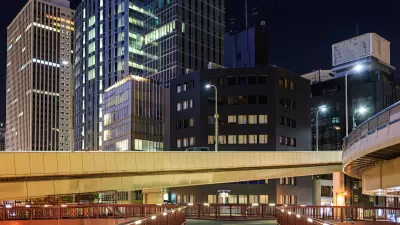Thanks in part to a state tax credit created in the early 2000s, downtown Dallas is set to create roughly 1,500 new housing units by converting office buildings to residential uses.

The office-to-residential conversion trend continues with a series of adaptive reuse projects in downtown Dallas that will bring roughly 1,500 new housing units to the area, per a story by Tucker Wells in the Dallas Business Journal. The population—and the median income—of the neighborhood is projected to grow from 6,000 to 8,000 people.
For downtown Dallas’ high-rise office buildings, adaptive reuse isn’t a new concept. According to Wells, “Dallas started to ‘stack uses’ into these 1980s-built Texas towers roughly 20 years ago. That was partly because of the stack of empty buildings in the city, but also due to a state historic tax credit that came online at the same time, according to Jennifer Picquet-Reyes, principal at Merriman Anderson Architects.” Developers began introducing hotels, restaurants, and upscale residences as a way to boost the downtown economy.
In addition to creating a mixed economy, “The growth of Downtown Dallas could end up culminating in the preservation of historic buildings through adaptive-reuse projects. ”
FULL STORY: Downtown Dallas set to experience renaissance with nearly 1,500 new residential units in the pipeline

Manufactured Crisis: Losing the Nation’s Largest Source of Unsubsidized Affordable Housing
Manufactured housing communities have long been an affordable housing option for millions of people living in the U.S., but that affordability is disappearing rapidly. How did we get here?

Americans May Be Stuck — But Why?
Americans are moving a lot less than they once did, and that is a problem. While Yoni Applebaum, in his highly-publicized article Stuck, gets the reasons badly wrong, it's still important to ask: why are we moving so much less than before?

Using Old Oil and Gas Wells for Green Energy Storage
Penn State researchers have found that repurposing abandoned oil and gas wells for geothermal-assisted compressed-air energy storage can boost efficiency, reduce environmental risks, and support clean energy and job transitions.

Greening Oakland’s School Grounds
With help from community partners like the Trust for Public Land, Oakland Unified School District is turning barren, asphalt-covered schoolyards into vibrant, green spaces that support outdoor learning, play, and student well-being.

California Governor Suspends CEQA Reviews for Utilities in Fire Areas
Utility restoration efforts in areas affected by the January wildfires in Los Angeles will be exempt from environmental regulations to speed up the rebuilding of essential infrastructure.

Native American Communities Prepare to Lead on Environmental Stewardship
In the face of federal threats to public lands and conservation efforts, indigenous groups continue to model nature-centered conservation efforts.
Urban Design for Planners 1: Software Tools
This six-course series explores essential urban design concepts using open source software and equips planners with the tools they need to participate fully in the urban design process.
Planning for Universal Design
Learn the tools for implementing Universal Design in planning regulations.
Heyer Gruel & Associates PA
City of Moreno Valley
Institute for Housing and Urban Development Studies (IHS)
City of Grandview
Harvard GSD Executive Education
Salt Lake City
NYU Wagner Graduate School of Public Service
City of Cambridge, Maryland





























